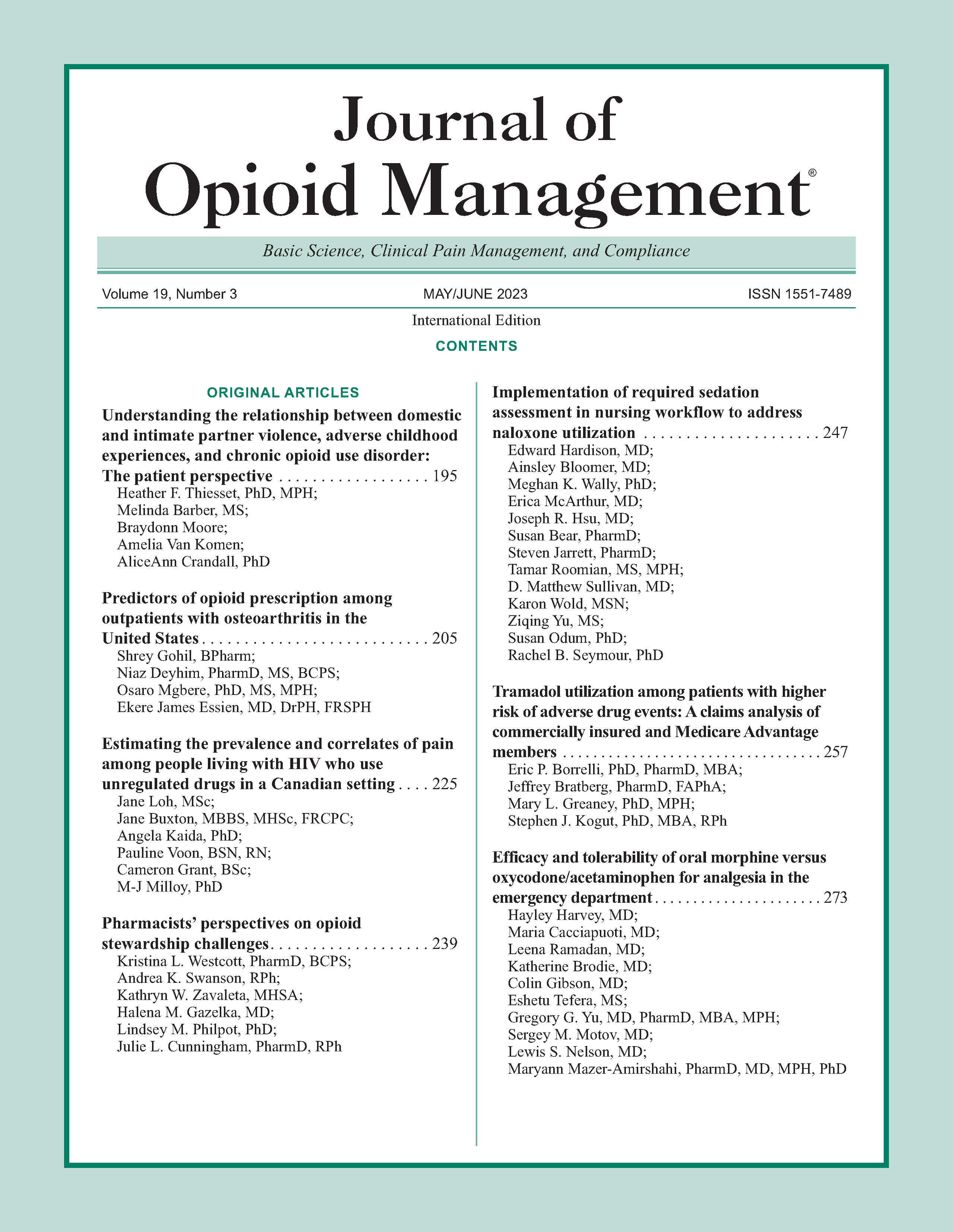Pharmacists’ perspectives on opioid stewardship challenges
DOI:
https://doi.org/10.5055/jom.2023.0779Keywords:
analgesics, focus groups, opioid analgesics, opioid stewardship, pharmacist, pharmacy education, prescriptionsAbstract
Objective: Pharmacists are in a distinctive position to champion opioid stewardship principles in communications with prescribers and patients. This effort is focused on elucidating perceived barriers to uphold these principles observed in pharmacy practice.
Design: Qualitative research study.
Setting: A healthcare system, consisting of inpatient and outpatient settings across several United States (US) states in both rural and academic settings.
Participants: Twenty-six pharmacists who represented the study setting in the sole healthcare system.
Interventions: Five virtual focus groups were conducted with the 26 pharmacists from inpatient and outpatient settings across four states in both rural and academic settings. Trained moderators conducted 1-hour focus group meetings that consisted of a mix of poll and discussion questions.
Main outcome measure: Participant questions were related to awareness, knowledge, and system issues affecting opioid stewardship.
Results: All pharmacists reported their routine follow-up with prescribers when questions or concerns arise but noted workload as a barrier to meticulous review of opioid prescriptions. Participants highlighted best practices, including transparency on the rationale for guideline exceptions to improve the management of after-hours concerns. Suggestions were integration of guidelines into prescriber and pharmacist order review workflows and a more visible prescriber review of prescription drug monitoring programs.
Conclusions: Improvements in communication and transparency of information related to opioid prescribing between pharmacists and prescribers would enhance opioid stewardship. Integration of opioid guidelines into opioid ordering and review would improve efficiency, guideline adherence, and, most importantly, patient care.
References
Chisholm-Burns MA, Spivey CA, Sherwin E, et al.: The opioid crisis: Origins, trends, policies, and the roles of pharmacists. Am J Health Syst Pharm. 2019; 76(7): 424-435. DOI: 10.1093/ajhp/zxy089.
Price ET: Demonstrated value in the public health arena: Pharmacist roles in addressing the current opioid crisis. J Am Pharm Assoc (2003). 2017; 57(5): 566-567. DOI: 10.1016/j.japh.2017.08.005.
Kolodny A, Courtwright DT, Hwang CS, et al.: The prescription opioid and heroin crisis: A public health approach to an epidemic of addiction. Annu Rev Public Health. 2015; 36: 559-574. DOI: 10.1146/annurev-publhealth-031914-122957.
Gibson M, Nguyen P, Casserly E, et al.: Pain management stewardship programs, part I: A review of legislative and regulatory changes. Hosp Pharm. 2021; 56: 124-132. DOI: 10.1177/0018578719868408.
Ghafoor VL, Phelps PK, Pastor J 3rd, et al.: Transformation of hospital pharmacist opioid stewardship. Hosp Pharm. 2019; 54(4): 266-273. DOI: 10.1177/0018578718809267.
Cochran G, Gordon AJ, Field C, et al.: Developing a framework of care for opioid medication misuse in community pharmacy. Res Social Adm Pharm. 2016; 12(2): 293-301. DOI: 10.1016/j.sapharm.2015.05.001.
Brushwood DB: Pharmacists face murky legal territory over concept of unresolvable ‘red flags. APhA Pharmacy Today. 2018; 24(4): 49. DOI: 10.1016/j.ptdy.2018.03.032.
Hartung DM, Hall J, Haverly SN, et al.: Pharmacists’ role in opioid safety: A focus group investigation. Pain Med. 2018; 19(9): 1799-1806. DOI: 10.1093/pm/pnx139.
Perrone J, Weiner SG, Nelson LS: Stewarding recovery from the opioid crisis through health system initiatives. West J Emerg Med. 2019; 20(2): 198-202. DOI: 10.5811/westjem.2018.11.39013.
Craig DS: The pharmacists’ role in patient-provider pain management treatment agreements. J Pharm Pract. 2012; 25(5): 510-516. DOI: 10.1177/0897190012453909.
Phelps P, Achey TS, Mieure KD, et al.: A survey of opioid medication stewardship practices at academic medical centers. Hosp Pharm. 2019; 54(1): 57-62. DOI: 10.1177/0018578718779005.
Tilli T, Kiran T, Dewhurst N, et al.: Opioid stewardship: Implementing proactive, pharmacist-led reviews for patients coprescribed opioids and benzodiazepines at an urban academic family health team. In Presented at CSHP Professional Practice Conference, Toronto, Canada, 2019.
Genord C, Frost T, Eid D: Opioid exit plan: A pharmacist's role in managing acute postoperative pain. J Am Pharm Assoc (2003). 2017; 57(2S): S92-S98. DOI: 10.1016/j.japh.2017.01.016.
Cochran G, Field C, Lawson K: Pharmacists who screen and discuss opioid misuse with patients: Future directions for research and practice. J Pharm Pract. 2015; 28(4): 404-412. DOI: 10.1177/0897190014522064.
Dowell D, Haegerich TM, Chou R: CDC guideline for prescribing opioids for chronic pain—United States. MMWR Recomm Rep. 2016; 65(1): 1-49. DOI: 10.15585/mmwr.rr6501e1.
Gregory T, Gregory L: The role of pharmacists in safe opioid dispensing. J Pharm Pract. 2020; 33(6): 856-862. DOI: 10.1177/0897190019852803.
Pope C, Ziebland S, Mays N: Qualitative research in health care. Analysing qualitative data. BMJ. 2000; 320(7227): 114-116. DOI: 10.1136/bmj.320.7227.114.
Braun V, Clarke V: Using thematic analysis in psychology. Qual Res Psychol. 2006; 3(2): 77-101. DOI: 10.1191/1478088706qp063oa.
Simmons-Yon A, Roth MT, Vu M, et al.: Understanding pharmacists’ experiences with advice-giving in the community pharmacy setting: A focus group study. Patient Educ Couns. 2012; 89(3): 476-483. DOI: 10.1016/j.pec.2012.08.011.
Tick H, Nielsen A, Pelletier KR, et al.: Evidence-based nonpharmacologic strategies for comprehensive pain care: The consortium pain task force white paper. Explore (NY). 2018; 14(3): 177-211. DOI: 10.1016/j.explore.2018.02.001.
Stratton TP, Palombi L, Blue H, et al.: Ethical dimensions of the prescription opioid abuse crisis. Am J Health Syst Pharm. 2018; 75(15): 1145-1150. DOI: 10.2146/ajhp170704.
Nguyen DQ, Chung B, Osburn LL, et al.: Utilization of pharmacists in addressing medication abuse in the pacific northwest. J Pharm Pract. 2017; 30(5): 528-533. DOI: 10.1177/0897190016652066.
Marlowe KF, Geiler R: Pharmacist's role in dispensing opioids for acute and chronic pain. J Pharm Pract. 2012; 25(5): 497-502. DOI: 10.1177/0897190010379710.
Published
How to Cite
Issue
Section
License
Copyright 2005-2025, Weston Medical Publishing, LLC and Journal of Opioid Management. All Rights Reserved.











